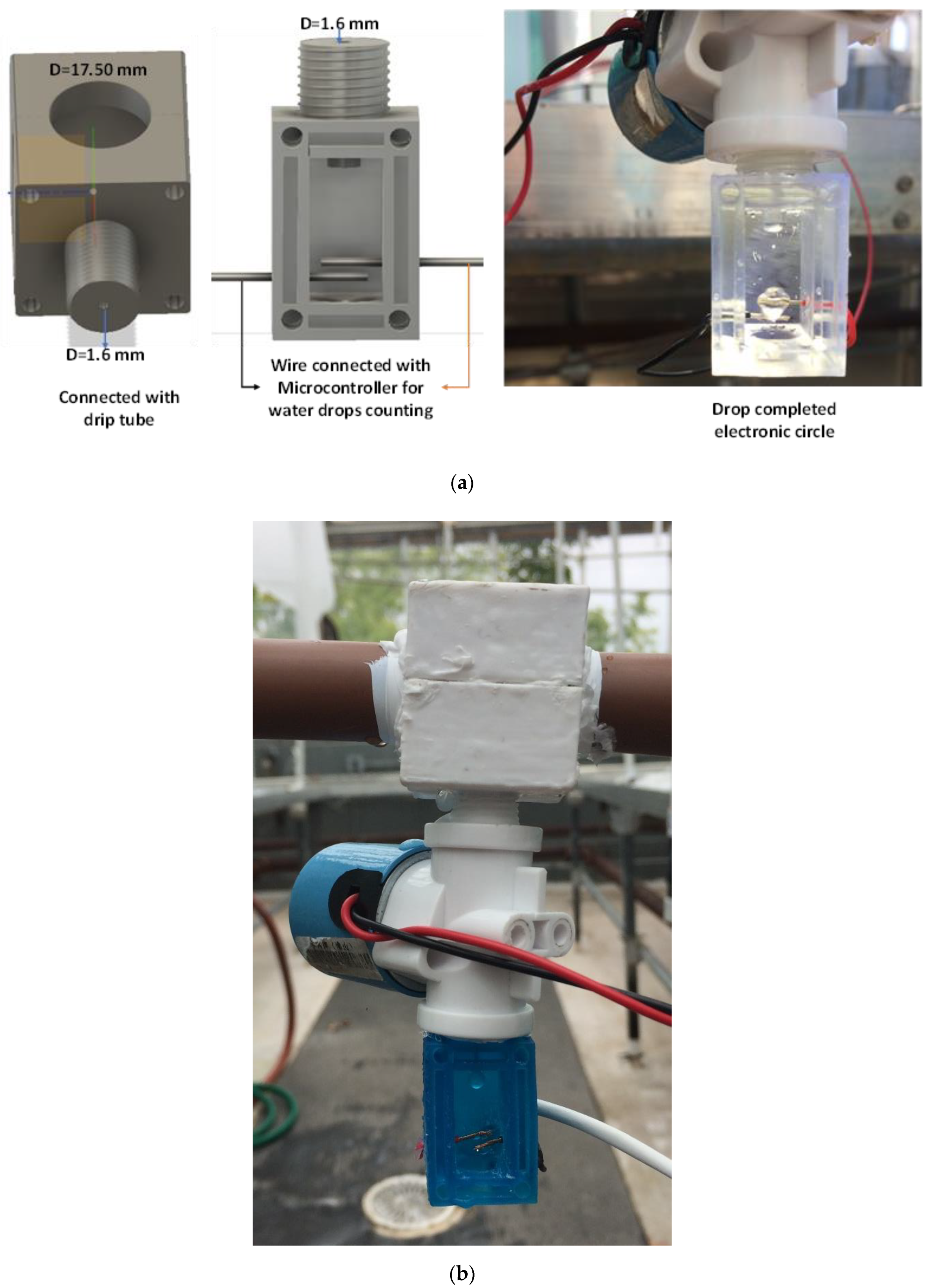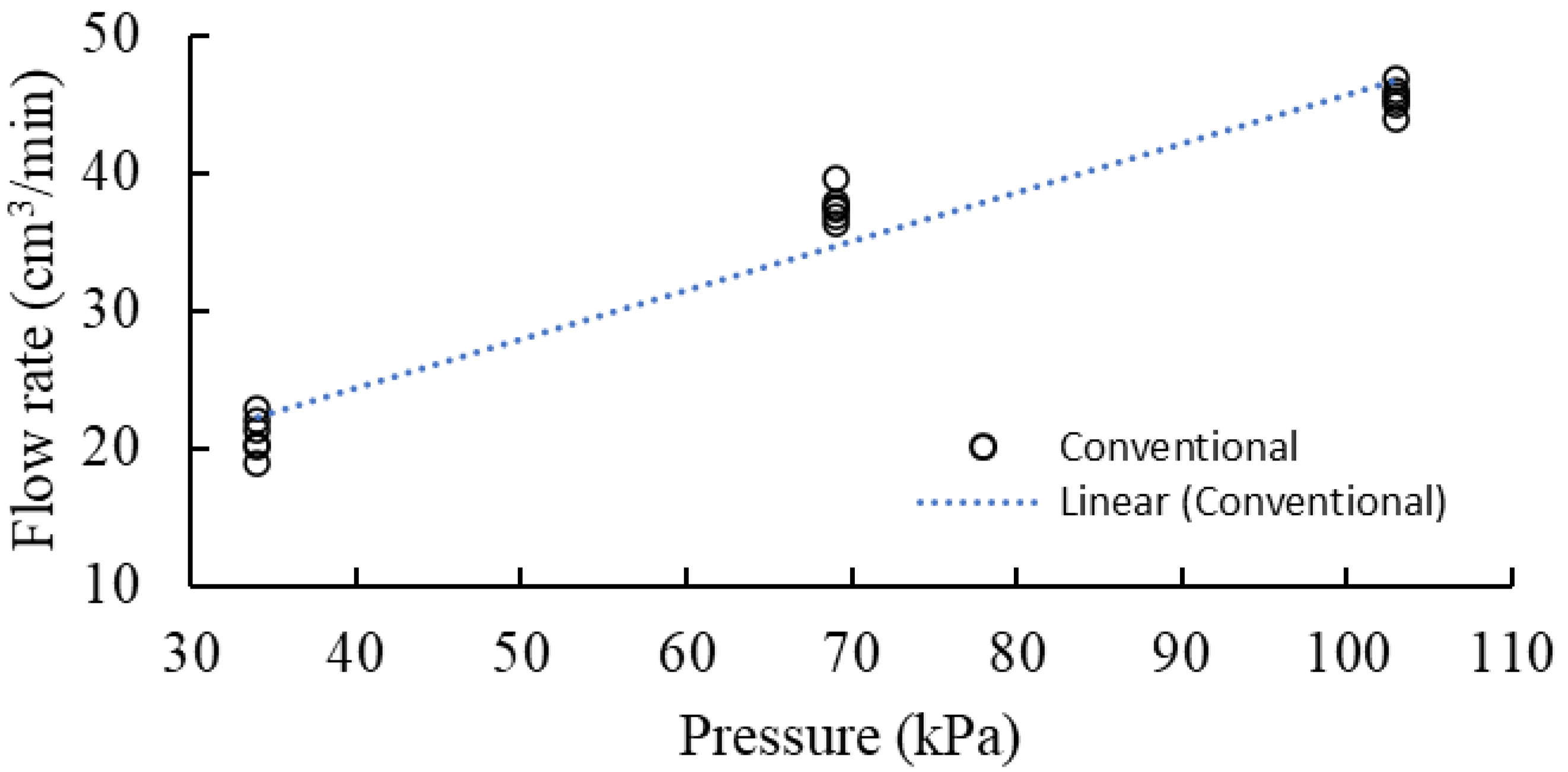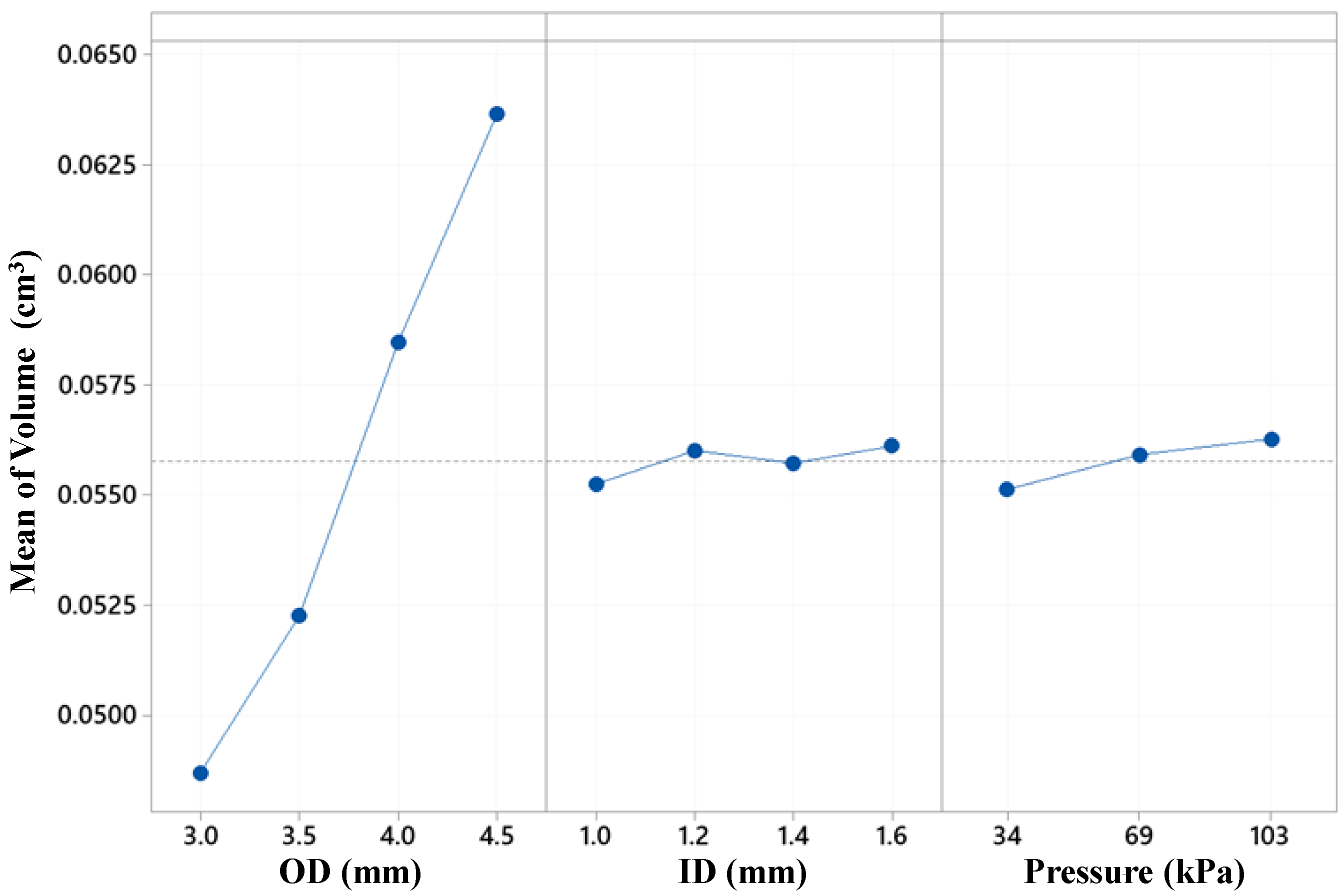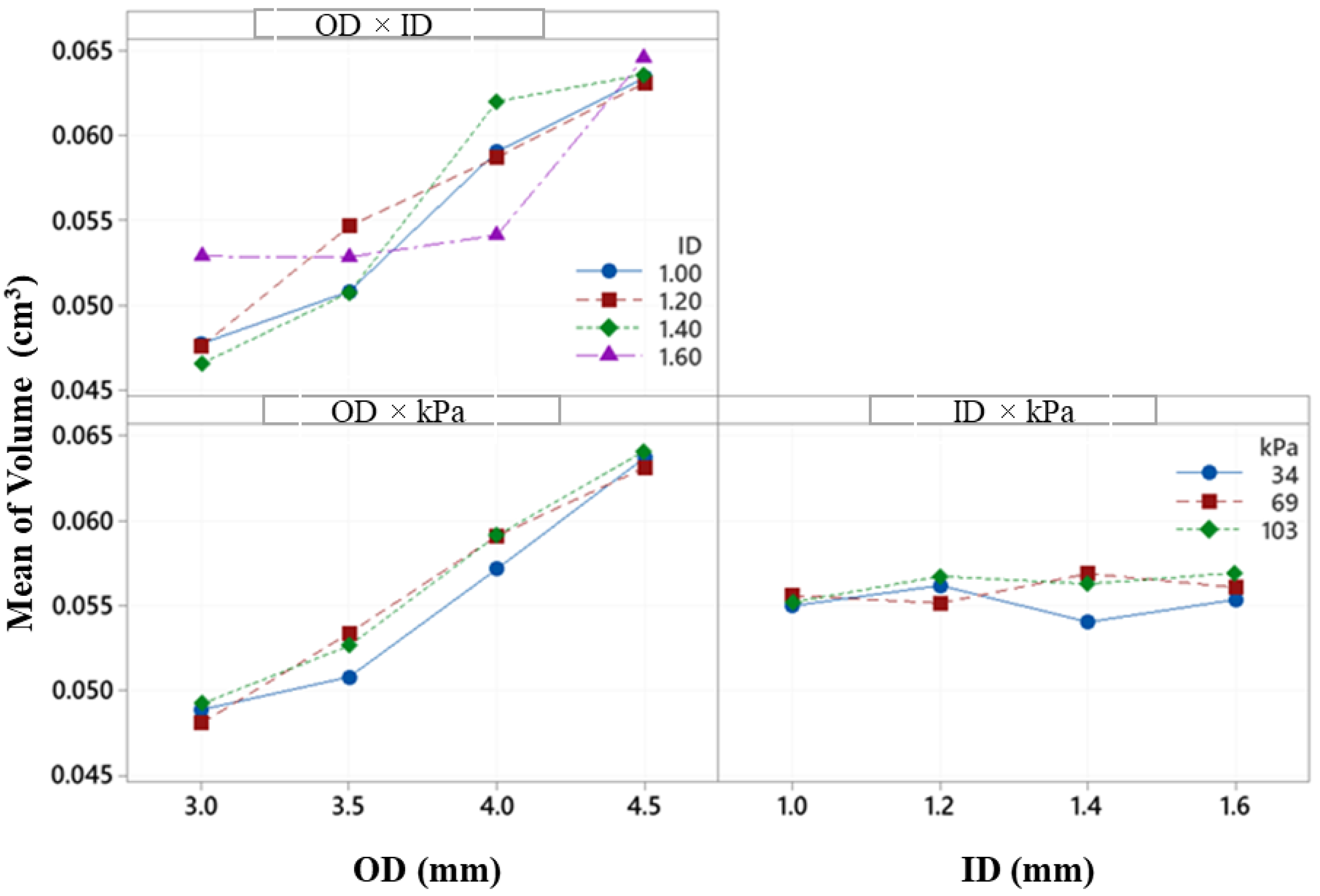Testing Novel New Drip Emitter with Variable Diameters for a Variable Rate Drip Irrigation
Abstract
1. Introduction
2. Materials and Methods
2.1. Lab Test
2.2. Data Analysis
2.2.1. Conventional Drip Data
2.2.2. VRI Drip Emitter
3. Result
3.1. Conventional Drip
3.2. VRDI Emitter Design Test
4. Discussion
5. Conclusions
Author Contributions
Funding
Data Availability Statement
Acknowledgments
Conflicts of Interest
References
- Taylor, R.; Zilberman, D. The Diffusion of Process Innovation: The Case of Drip Irrigation in California. In Proceedings of the 2015 Agricultural & Applied Economics Association and Western Agricultural Economics Association Annual Meeting, San Francisco, CA, USA, 26–28 July 2015. [Google Scholar]
- Van Der Kooij, S.; Zwarteveen, M.; Boesveld, H.; Kuper, M. The efficiency of drip irrigation unpacked. Agric. Water Manag. 2013, 123, 103–110. [Google Scholar] [CrossRef]
- Chitra, R.; Havaraddi, R.M.; Subramanian, S.; Suresh, J. Effect of scheduling of drip irrigation on growth, yield and water use efficiency of turmeric (Curcuma longa L.) var. CO2. J. Spices Aromat. Crop. 2017, 26. [Google Scholar] [CrossRef]
- Ayers, J.; Fulton, A.; Taylor, B. Subsurface drip irrigation in California—Here to stay? Agric. Water Manag. 2015, 157, 39–47. [Google Scholar] [CrossRef]
- Fan, J.; Zhang, F.; Wu, L.; Yan, S.; Xiang, Y. Field evaluation of fertigation uniformity in drip irrigation system with pressure differential tank. Trans. Chin. Soc. Agric. Eng. 2016, 32, 96–101. [Google Scholar]
- Chapin, R.D. Drip Irrigation System. U.S. Patent 4,626,130, 2 December 1986. [Google Scholar]
- AL-agele, H.A.; Higgins, C.W. Electromechanical Drip Irrigation Device. U.S. Patent Application No. 17/073,814.
- Perry, C.; Pocknee, S.; Hansen, O. A variable rate pivot irrigation control system. In Proceedings of the Fourth European Conference in Presicion Agriculture, Berlin, Germany, 15–19 June 2003; pp. 539–544. [Google Scholar]
- Higgins, C.W.; Kelley, J.; Barr, C.; Hillyer, C. Determining the minimum management scale of a commercial variable-rate irrigation system. Trans. ASABE 2016, 59, 1671–1680. [Google Scholar]
- Rodriguez, S.A.B.; Hamann, H.F.; Klein, L.; Schappert, M.A. Segmented Variable Rate Drip Irrigation. U.S. Patent 9,877,438, 30 January 2018. [Google Scholar]
- Sanchez, L.; Sams, B.; Alsina, M.M.; Hinds, N.; Klein, L.J.; Dokoozlian, N. Improving vineyard water use efficiency and yield with variable rate irrigation in California. Adv. Anim. Biosci. 2017, 8, 574–577. [Google Scholar] [CrossRef]
- Nadav, I.; Schweitzer, A. VRDI—Variable Rate Drip Irrigation in Vineyards. Adv. Anim. Biosci. 2017, 8, 569–573. [Google Scholar] [CrossRef]
- Ortuani, B.; Facchi, A.; Mayer, A.; Bianchi, D.; Bianchi, A. Water Assessing the Effectiveness of Variable-Rate Drip Irrigation on Water Use Efficiency in a Vineyard in Northern Italy. Water 2019, 11, 1964. [Google Scholar] [CrossRef]
- Ortuani, B.; Facchi, A.; Mayer, A.; Ronchetti, G.; Sona, G.; Brancadoro, L. Improvement of water use efficiency in an Italian vineyard through variable rate drip irrigation. In Proceedings of the 21st EGU General Assembly, EGU2019, Vienna, Austria, 7–12 April 2019. [Google Scholar]
- Shilpa, A. Smart Drip Irrigation System. Int. J. Trend Sci. Res. Dev. 2018, 2, 1560–1565. [Google Scholar]
- Parameswaran, G.; Sivaprasath, K. Arduino based smart drip irrigation system using Internet of Things. Int. J. Eng. Sci. 2016, 6, 5518. [Google Scholar]
- O’Donnell, S.; Fiocca, K.; Campbell, M.; Bulova, S.; Zelanko, P.; Velinsky, D. Adult nutrition and reproductive physiology: A stable isotope analysis in a eusocial paper wasp (Mischocyttarus mastigophorus, Hymenoptera: Vespidae). Behav. Ecol. Sociobiol. 2018, 72, 86. [Google Scholar] [CrossRef]




| ID (mm) | OD (mm) | Pressure (kPa) | Replicates | Time for Each Replicate (min) |
|---|---|---|---|---|
| Conventional | 34, 69, 103 | 6 | 10 | |
| 1 | 3, 3.5, 4, 4.5 | 34, 69, 103 | 6 | 10 |
| 1.2 | 3, 3.5, 4, 4.5 | 34, 69, 103 | 6 | 10 |
| 1.4 | 3, 3.5, 4, 4.5 | 34, 69, 103 | 6 | 10 |
| 1.6 | 3, 3.5, 4, 4.5 | 34, 69, 103 | 6 | 10 |
| Drip Emitter Type | Pressure (kPa) | |||
|---|---|---|---|---|
| 34 | 69 | 103 | ||
| Flow Rate μ ± SD (cm3/min) | ||||
| Inner Diameter (mm) | Outside Diameter (mm) | |||
| 1 | 3 | 2.50 ± 2.11 | 4.97 ± 0.25 | 6.87 ± 0.10 |
| 3.5 | 2.11 ± 0.00 | 3.53 ± 0.07 | 4.12 ± 0.32 | |
| 4 | 2.98 ± 0.06 | 4.49 ± 0.05 | 5.98 ± 0.23 | |
| 4.5 | 2.13 ± 0.07 | 4.19 ± 0.18 | 5.75 ± 0.16 | |
| 1.2 | 3 | 3.06 ± 0.12 | 4.62 ± 0.07 | 6.58 ± 0.10 |
| 3.5 | 1.82 ± 0.10 | 3.52 ± 0.37 | 4.34 ± 0.09 | |
| 4 | 2.01 ± 0.24 | 4.35 ± 0.06 | 5.79 ± 0.14 | |
| 4.5 | 1.83 ± 0.05 | 4.14 ± 0.10 | 5.48 ± 0.16 | |
| 1.4 | 3 | 2.85 ± 0.28 | 4.82 ± 0.11 | 6.32 ± 0.12 |
| 3.5 | 2.11 ± 0.17 | 4.11 ± 0.12 | 5.55 ± 0.38 | |
| 4 | 2.73 ± 0.03 | 4.42 ± 0.19 | 6.12 ± 0.04 | |
| 4.5 | 1.92 ± 0.09 | 3.55 ± 0.13 | 5.21 ± 0.04 | |
| 1.6 | 3 | 1.97 ± 0.10 | 3.46 ± 0.07 | 4.30 ± 0.26 |
| 3.5 | 2.59 ± 0.42 | 4.91 ± 0.13 | 6.05 ± 0.15 | |
| 4 | 2.00 ± 0.06 | 4.30 ± 0.09 | 5.69 ± 0.28 | |
| 4.5 | 1.94 ± 0.03 | 3.85 ± 0.08 | 4.87 ± 0.25 | |
| Commercial drip tube | 20.89 ± 1.43 | 37.61 ± 1.13 | 45.43 ± 0.98 | |
| Source of Variance | Degree of Freedom (DF) | Adjusted Sum of Squares (Adj SS) | Adjusted Mean Squares (Adj MS) | F-Value | p-Value |
|---|---|---|---|---|---|
| Pressure [kPa] | 2 | 6.60 × 10−5 | 3.30 × 10−5 | 2.89 | 0.057 |
| OD [mm] | 3 | 2.82 × 10−3 | 9.38 × 10−4 | 82.31 | 0 |
| ID(OD) [mm] | 12 | 1.22 × 10−3 | 1.01 × 10−4 | 8.89 | 0 |
| Error | 270 | 3.08 × 10−3 | 1.10 × 10−5 | ||
| Lack-of-Fit | 30 | 4.97 × 10−4 | 1.70 × 10−5 | 1.54 | 0.041 |
| Pure Error | 240 | 2.58 × 10−3 | 1.10 × 10−5 | ||
| Total | 287 | 1.38 × 10−2 |
Publisher’s Note: MDPI stays neutral with regard to jurisdictional claims in published maps and institutional affiliations. |
© 2021 by the authors. Licensee MDPI, Basel, Switzerland. This article is an open access article distributed under the terms and conditions of the Creative Commons Attribution (CC BY) license (http://creativecommons.org/licenses/by/4.0/).
Share and Cite
AL-agele, H.A.; Nackley, L.; Higgins, C. Testing Novel New Drip Emitter with Variable Diameters for a Variable Rate Drip Irrigation. Agriculture 2021, 11, 87. https://doi.org/10.3390/agriculture11020087
AL-agele HA, Nackley L, Higgins C. Testing Novel New Drip Emitter with Variable Diameters for a Variable Rate Drip Irrigation. Agriculture. 2021; 11(2):87. https://doi.org/10.3390/agriculture11020087
Chicago/Turabian StyleAL-agele, Hadi A., Lloyd Nackley, and Chad Higgins. 2021. "Testing Novel New Drip Emitter with Variable Diameters for a Variable Rate Drip Irrigation" Agriculture 11, no. 2: 87. https://doi.org/10.3390/agriculture11020087
APA StyleAL-agele, H. A., Nackley, L., & Higgins, C. (2021). Testing Novel New Drip Emitter with Variable Diameters for a Variable Rate Drip Irrigation. Agriculture, 11(2), 87. https://doi.org/10.3390/agriculture11020087






